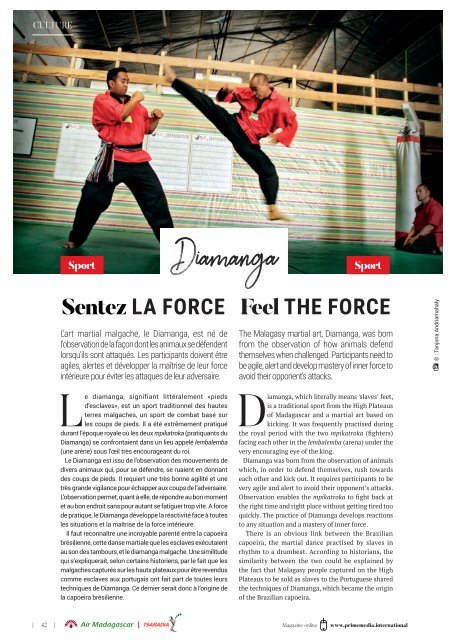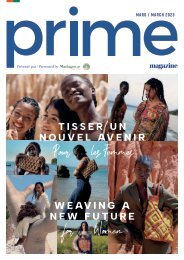Prime Magazine April 2020
Prime Magazine April 2020
Prime Magazine April 2020
You also want an ePaper? Increase the reach of your titles
YUMPU automatically turns print PDFs into web optimized ePapers that Google loves.
CULTURE<br />
Sport<br />
Diamanga<br />
Sport<br />
Sentez LA FORCE<br />
L'art martial malgache, le Diamanga, est né de<br />
l'observation de la façon dont les animaux se défendent<br />
lorsqu'ils sont attaqués. Les participants doivent être<br />
agiles, alertes et développer la maîtrise de leur force<br />
intérieure pour éviter les attaques de leur adversaire.<br />
L<br />
e diamanga, signifiant littéralement «pieds<br />
d’esclaves», est un sport traditionnel des hautes<br />
terres malgaches, un sport de combat basé sur<br />
les coups de pieds. Il a été extrêmement pratiqué<br />
durant l’époque royale où les deux mpikatroka (pratiquants du<br />
Diamanga) se confrontaient dans un lieu appelé lembalemba<br />
(une arène) sous l’œil très encourageant du roi.<br />
Le Diamanga est issu de l’observation des mouvements de<br />
divers animaux qui, pour se défendre, se ruaient en donnant<br />
des coups de pieds. Il requiert une très bonne agilité et une<br />
très grande vigilance pour échapper aux coups de l’adversaire.<br />
L’observation permet, quant à elle, de répondre au bon moment<br />
et au bon endroit sans pour autant se fatiguer trop vite. A force<br />
de pratique, le Diamanga développe la réactivité face à toutes<br />
les situations et la maîtrise de la force intérieure.<br />
Il faut reconnaître une incroyable parenté entre la capoeira<br />
brésilienne, cette danse martiale que les esclaves exécutaient<br />
au son des tambours, et le diamanga malgache. Une similitude<br />
qui s’expliquerait, selon certains historiens, par le fait que les<br />
malgaches capturés sur les hauts plateaux pour être revendus<br />
comme esclaves aux portugais ont fait part de toutes leurs<br />
techniques de Diamanga. Ce dernier serait donc à l’origine de<br />
la capoeira brésilienne.<br />
Feel THE FORCE<br />
The Malagasy martial art, Diamanga, was born<br />
from the observation of how animals defend<br />
themselves when challenged. Participants need to<br />
be agile, alert and develop mastery of inner force to<br />
avoid their opponent’s attacks.<br />
Diamanga, which literally means 'slaves’ feet,<br />
is a traditional sport from the High Plateaus<br />
of Madagascar and a martial art based on<br />
kicking. It was frequently practised during<br />
the royal period with the two mpikatroka (fighters)<br />
facing each other in the lembalemba (arena) under the<br />
very encouraging eye of the king.<br />
Diamanga was born from the observation of animals<br />
which, in order to defend themselves, rush towards<br />
each other and kick out. It requires participants to be<br />
very agile and alert to avoid their opponent’s attacks.<br />
Observation enables the mpikatroka to fight back at<br />
the right time and right place without getting tired too<br />
quickly. The practice of Diamanga develops reactions<br />
to any situation and a mastery of inner force.<br />
There is an obvious link between the Brazilian<br />
capoeira, the martial dance practised by slaves in<br />
rhythm to a drumbeat. According to historians, the<br />
similarity between the two could be explained by<br />
the fact that Malagasy people captured on the High<br />
Plateaus to be sold as slaves to the Portuguese shared<br />
the techniques of Diamanga, which became the origin<br />
of the Brazilian capoeira.<br />
© : Tanjona Andriamahaly<br />
| 42 | <strong>Magazine</strong> online www.primemedia.international

















